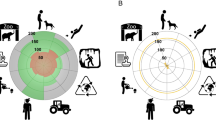Abstract
It is generally believed that forests are perceived differently according to the cultural background of the visitor. Different cultural groups tend to have diverse perceptions of tree species, landscapes, or gardens. In this research project, we conducted interviews of German and Japanese groups (each group consisting of three or more people), to identify their perspectives in exploring the theme of “cut” and “dead” wood. For this purpose, we interviewed 20 groups from each cultural background (40 data sets in total). Each group was asked to categorize 36 pictures chosen from photographic contests. The results were examined with PCA and cluster analysis. The quantified results of the two national groups highlighted the dichotomy of the cut and dead wood relationship. The method and materials used gave robust results. Differences between the two groups were identified by their perceptions of cut and dead wood. The results are insightful from a methodological and political rationale. First, new insights were gained by adopting group-based interviews using pictures from photographic contests. Research about public perceptions in forest science is often dominated by a focus on verbal inquiry. This study explored similar questions, using visual materials. The interviews consisted of visual materials to overcome bias in languages or the question order. Second, the results indicated the influence of “close-to-nature forestry” policy on public perceptions. While German society has a wide practice of leaving dead wood in forests based on their close-to-nature forestry policy, there is no equivalent Japanese concept. Although Japan and Germany both face pressures for economic restructuring and public participation, the difference in public perception of forestry can lead to a difference in acceptance for the same policy. If such differences are to exist, we can observe that the legitimacy of forestry in the two countries is reconstructed in different ways.
Similar content being viewed by others
References
RI Alfaro G Mery M Lobovikov (2005) ArticleTitleImplications of on-going paradigm changes for policy decisions in forestry and related sectors. Proceedings of 22nd IUFRO World Congress Int Forest Rev 7 262
K Al-Kodmany (1999) ArticleTitleUsing visualization techniques for enhancing public participation in planning and design: process, implementation, and evaluation Landscape Urban Plan 45 37–45
Biermayer G (1999) Totes Holz gehört zum lebendigen Wald. LWF aktuell 18: 1. http://www.lwf.bayern.de/veroeffentlichungen/lwf-aktuell/18.php. Cited on 3 June 2005
Bundesministerium für Verbraucherschutz, Ernährung und Landwirtschaft (BMVEL) (2004) Die zweite Bundeswaldinventur – BWI2. Berlin, BMVEL. http://www.bundeswaldinventur.de/media/archive/214.pdf. Cited on 3 June 2005
J Butler F Currie K Kirby (2002) ArticleTitleThere's life in that dead wood – so leave some in your woodland Q J Forest 96 131–137
TC Daniel MM Meitner (2001) ArticleTitleRepresentational validity of landscape visualizations: the effects of the graphical realism on perceived scenic beauty of forest vistas J Environ Psychol 21 61–72 Occurrence Handle10.1006/jevp.2000.0182
InstitutionalAuthorNameForestry Agency of Japan (1998) Forestry white paper (in Japanese) Nihon Rinngyou Kyoukai Tokyo
Kajiyama H (2005) Reviving the Japanese forest industry: a comparative study of Japan and Germany. Fujitsu Research Institute Research Paper, FRI Research Report Series No.216. Tokyo
J Knight (1996) When timber grows wild: the desocialisation of Japanese mountain forests P Desola G Pálsson (Eds) Nature and society: anthropological perspectives Routledge London 221–240
Kohsaka R (2004) Contests of natural beauty: an empirical enquiry into forestry-related photographic competitions based on group interviews in Japan and Germany. Kessel, Remagen-Oberwinter
Kohsaka R, Dembczynski K (2004) Exploring criteria in forest aesthetics: rough sets theory and discourse analysis. International Institute for Applied Systems Analysis, Interim Report IR-03-038, Laxenburg, Austria
R Kohsaka M Flitner (2004) ArticleTitleExploring forest aesthetics using forestry photo contests: case studies examining Japanese and German public preferences Forest Policy Econ 6 297–308
GR North TL Bell RF Cahalan FJ Moeng (1982) ArticleTitleSampling errors in the estimation of empirical orthogonal functions Mon Weather Rev 110 699–706
M Runkel (2000) Freiburger Waldansichten Stadt Freiburg Freiburg im Breisgau
C Schaper (1992) ArticleTitleTotholz im Wirtschaftswald Allgemeine Forstzeitschrift 47 598–599
W Scherzinger (1996) Naturschutz im Wald: Qualitätsziele einer dynamischen Waldentwicklung Ulmer Stuttgart
Schmidt O (1999) Waldschutz und Totholz. LWF aktuell 18:26–27. http://www.lwf.bayern.de/veroeffentlichungen/lwf-aktuell/18.php. Citedon 3 June 2005
M Suda B Pauli V Mages U Klins (1998) ArticleTitleWald Holz und Forstwirtschaft im Spiegel der öffentlichen Meinung. Forstliche Forschungsberichte München 172 49–68
M Yamagata (1994) ArticleTitle“Wald” und “Forst” sowie Japanische “Mori”, “Hayashi” und “Shinrin”: Über den Bedeutungsunterschied zwischen Diesen Wörter (in Japanese) Rev Forest Cult 15 143–156
Author information
Authors and Affiliations
Corresponding author
About this article
Cite this article
Kohsaka, R., Handoh, I. Perceptions of “close-to-nature forestry” by German and Japanese groups: inquiry using visual materials of “cut” and “dead” wood. J For Res 11, 11–19 (2006). https://doi.org/10.1007/s10310-005-0177-4
Received:
Accepted:
Issue Date:
DOI: https://doi.org/10.1007/s10310-005-0177-4




